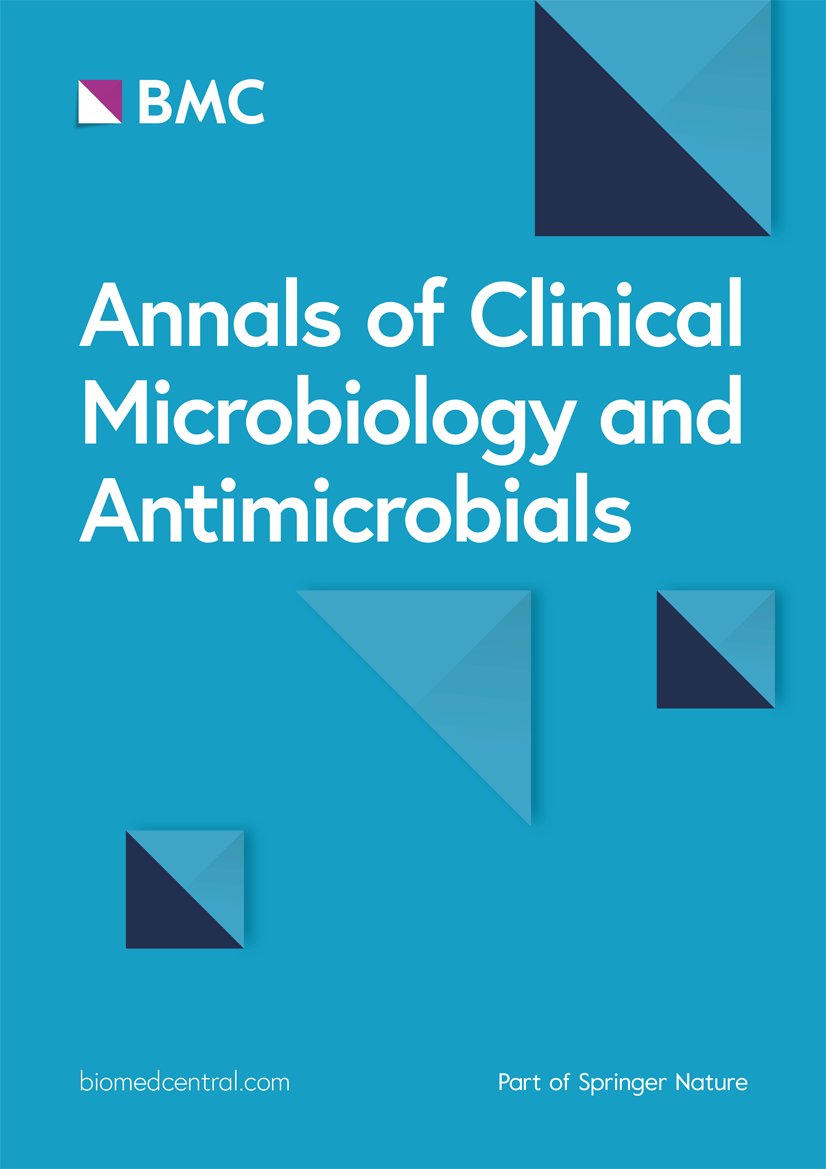Molecular characterization of extended-spectrum β-lactamase-producing Escherichia coli isolated from lower respiratory tract samples between 2002 and 2019 in the Central Slovenia region
IF 4.6
2区 医学
Q1 MICROBIOLOGY
Annals of Clinical Microbiology and Antimicrobials
Pub Date : 2024-01-13
DOI:10.1186/s12941-023-00664-1
引用次数: 0
Abstract
Antibiotic resistance is one of the most serious global health problems and threatens the effective treatment of bacterial infections. Of greatest concern are infections caused by extended-spectrum β-lactamase-producing Escherichia coli (ESBL-EC). The aim of our study was to evaluate the prevalence and molecular characteristics of ESBL-EC isolated over an 18-year pre-COVID period from lower respiratory tract (LRT) samples collected from selected Slovenian hospitals. All isolates were identified by MALDI-TOF and phenotypically confirmed as ESBLs by a disk diffusion assay. Using a PCR approach, 487 non-repetitive isolates were assigned to phylogroups, sequence type groups, and clonal groups. Isolates were also screened for virulence-associated genes (VAGs) and antimicrobial resistance genes. The prevalence of ESBL-EC isolates from LRT in a large university hospital was low (1.4%) in 2005 and increased to 10.8% by 2019. The resistance profile of 487 non-repetitive isolates included in the study showed a high frequency of group 1 blaCTX-M (77.4%; n = 377), blaTEM (54.4%; n = 265) and aac(6')-Ib-cr (52%; n = 253) genes and a low proportion of blaSHV and qnr genes. Isolates were predominantly assigned to phylogroup B2 (73.1%; n = 356), which was significantly associated with clonal group ST131. The ST131 group accounted for 67.6% (n = 329) of all isolates and had a higher number of virulence factor genes than the non-ST131 group. The virulence gene profile of ST131 was consistent with that of other extraintestinal pathogenic E. coli (ExPEC) strains and was significantly associated with ten of sixteen virulence factor genes tested. Using ERIC-PCR fingerprinting, isolates with the same ERIC-profile in samples from different patients, and at different locations and sampling dates were confirmed, indicating the presence of “hospital-adapted” strains. Our results suggest that the ESBL-EC isolates from LRT do not represent a specific pathotype, but rather resemble other ExPEC isolates, and may be adapted to the hospital environment. To our knowledge, this is the first study of ESBL-EC isolated from LRT samples collected over a long period of time.2002 年至 2019 年期间从斯洛文尼亚中部地区下呼吸道样本中分离出的产扩展谱 β-内酰胺酶大肠埃希菌的分子特征描述
抗生素耐药性是最严重的全球健康问题之一,威胁着细菌感染的有效治疗。最令人担忧的是由产广谱β-内酰胺酶大肠埃希菌(ESBL-EC)引起的感染。我们的研究旨在评估 COVID 前 18 年间从斯洛文尼亚部分医院采集的下呼吸道(LRT)样本中分离出的 ESBL-EC 的流行率和分子特征。所有分离物均通过 MALDI-TOF 进行鉴定,并通过磁盘扩散试验进行表型确认为 ESBLs。采用 PCR 方法将 487 个非重复性分离株归入系统组、序列类型组和克隆组。此外,还对分离株进行了毒力相关基因(VAG)和抗菌药耐药性基因的筛查。2005 年,一家大型大学医院从 LRT 分离出的 ESBL-EC 感染率较低(1.4%),到 2019 年已增至 10.8%。研究中 487 个非重复分离株的耐药性特征显示,第 1 组 blaCTX-M(77.4%;n = 377)、blaTEM(54.4%;n = 265)和 aac(6')-Ib-cr (52%;n = 253)基因的频率较高,而 blaSHV 和 qnr 基因的比例较低。分离菌主要归入系统组 B2(73.1%;n = 356),该系统组与克隆组 ST131 显著相关。ST131组占所有分离株的67.6%(n = 329),其毒力因子基因数量高于非ST131组。ST131 的毒力基因谱与其他肠道外致病性大肠杆菌(ExPEC)菌株的毒力基因谱一致,并与所检测的 16 个毒力因子基因中的 10 个基因有显著关联。通过ERIC-PCR指纹图谱分析,从不同患者、不同地点和不同采样日期的样本中分离出的具有相同ERIC图谱的菌株得到了证实,这表明存在 "医院适应型 "菌株。我们的研究结果表明,从 LRT 分离出的 ESBL-EC 并不代表一种特定的病原型,而是与其他 ExPEC 分离物相似,并可能适应了医院环境。据我们所知,这是首次对从长期收集的 LRT 样本中分离出的 ESBL-EC 进行研究。
本文章由计算机程序翻译,如有差异,请以英文原文为准。
求助全文
约1分钟内获得全文
求助全文
来源期刊

Annals of Clinical Microbiology and Antimicrobials
MICROBIOLOGY-
CiteScore
8.60
自引率
0.00%
发文量
49
审稿时长
>12 weeks
期刊介绍:
Annals of Clinical Microbiology and Antimicrobials considers good quality, novel and international research of more than regional relevance. Research must include epidemiological and/or clinical information about isolates, and the journal covers the clinical microbiology of bacteria, viruses and fungi, as well as antimicrobial treatment of infectious diseases.
Annals of Clinical Microbiology and Antimicrobials is an open access, peer-reviewed journal focusing on information concerning clinical microbiology, infectious diseases and antimicrobials. The management of infectious disease is dependent on correct diagnosis and appropriate antimicrobial treatment, and with this in mind, the journal aims to improve the communication between laboratory and clinical science in the field of clinical microbiology and antimicrobial treatment. Furthermore, the journal has no restrictions on space or access; this ensures that the journal can reach the widest possible audience.
 求助内容:
求助内容: 应助结果提醒方式:
应助结果提醒方式:


